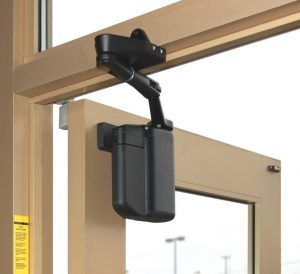By Scott Thomas
I wrote about my experience designing an accessible home in part one, now we will cover the more exciting “smart home” dynamic. When designing an accessible and smart home it’s important to think of what electrical needs you will have.
Outlet placement is a crucial component of design to ensure a home is ready to be made smart. I made sure I had adequate outlets for my equipment. I also placed outlets above windows where I planned on placing electric blinds, and installed an outlet above a door for an automatic door opener.
There are two routes you can take when making your home smart. You can hire someone to set everything up for you, or do it yourself. We initially intended to hire a private contractor to take care of everything for us, but after a couple bids nearing $20,000 we made the decision to do it ourselves. We found that the most difficult part creating our own “smart home” is the research. Although I do have a strong understanding of technology, the setup for products was fairly simple. So far, we have made great progress and have spent under $1000 (not including blinds) to make our home “smart.”

*An example of a home with automatic blinds.
Electric blinds are more expensive, but they can be a life-changer in an accessible home. The afternoon sunshine can be blinding, and they come with an easy to use remote. I’ve found that being able to lower the blind with the click of a button is empowering. I used the remote for some time, but now I need and can operate the blinds through my computer.
We have found that Wemo products are a great inexpensive solution to many home automation projects. The Wemo Maker is advertised to be able to automate doors, blinds, garage doors, etc. I use the Wemo Switch ($30) to turn my office lamp on and off from the free Wemo app on my computer. The Wemo Switch plugs into an outlet, then you will plug-in the device you intend to use into the switch.

*An example of a residential door opener.
Another cool, inexpensive product we have found is the Wink lighting kit ($97). It comes with two light bulbs and a receiver to plug-in to an outlet. Just screw in the bulbs, plug-in the receiver, download the Wink app, and you’re done.
A remote control app for TV is another affordable accessibility feature. There are a variety of remote control apps and they are typically only a few dollars. The apps can be downloaded to your phone or computer. If your TV isn’t smart, you can use devices such as Roku or Amazon Fire Stick to make your TV smart for as little as $20.
The Nest thermostat is my favorite part of our smart home. I bought the old version on Amazon.com ($200) because the new version didn’t have any features I was willing to pay more for. You can control the Nest thermostat with your phone or your computer from anywhere in the world that has an Internet connection. The Nest memorizes your schedule so you don’t have to adjust the temperature constantly. The Nest conserves energy by shutting down when you’re away.

*Automated Nest thermostat.
Smart homes can make anyone’s life easier, but for someone who is disabled, a smart home can instill a great deal of independence and will allow you to control your home functions with your computer or phone,. The big advantage of doing it yourself is cost savings, the biggest downside is that you have to do it all yourself!
Have questions about Scott’s smart home? Ask Scott Thomas at scottthomas4110@gmail.com
Call MonTECH at 1-877-243-5511 to set up an assistive technology demonstration appointment, learn more about AT devices, or to ask questions about our services.
